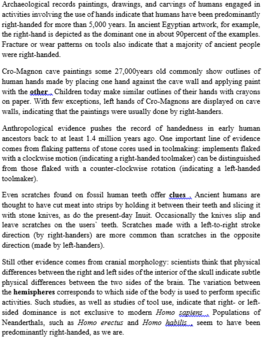Read the following passage and mark the letter A, B, C, or D on your answer sheet to indicate the correct answer to each of the questions from 28 to 34.
Some animal behaviorists argue that certain animals can remember past events, anticipate future ones, make plans and choices, and coordinate activities within a group. These scientists, however, are cautious about the extent to which animals can be credited with conscious processing.
Explanations of animal behavior that leave out any sort of consciousness at all and ascribe actions entirely to instinct leave many questions unanswered. One example of such unexplained behavior: Honeybees communicate the sources of nectar to one another by doing a dance in a figure-eight pattern. The orientation of the dance conveys the position of the food relative to the sun’s position in the sky, and the speed of the dance tells how far the food source is from the hive. Most researchers assume that the ability to perform and encode the dance is innate and shows no special intelligence. But in one study, when experimenters kept changing the site of the food source, each time moving the food 25 percent farther from the previous site, foraging honeybees began to anticipate where the food source would appear next. When the researchers arrived at the new location, they would find the bees circling the spot, waiting for their food. No one has yet explained how bees, whose brains weigh four ten-thousandths of an ounce, could have inferred the location of the new site.
Other behaviors that may indicate some cognition include tool use. Many animals, like the otter who uses a stone to crack mussel shells, are capable of using objects in the natural environment as rudimentary tools. One researcher has found that mother chimpanzees occasionally show their young how to use tools to open hard nuts. In one study, chimpanzees compared two pairs of food wells containing chocolate chips. Allowed to choose which pair they wanted, the chimpanzees almost always chose the one with the higher total, showing some sort of summing ability. Other chimpanzees have learned to use numerals to label quantities of items and do simple sums.
The phrase “the one” in paragraph 3 refers to the _________ .
A. study
B. pair
C. chimpanzee
D. ability






Chọn đáp án B
Cụm từ “the one” trong đoạn 3 đề cập đến _________.
“Allowed to choose which pair they wanted, the chimpanzees almost always chose the one with the higher total, showing some sort of summing ability.” (Được phép chọn cặp nào mà chúng muốn thì những con tinh tinh hầu như luôn chọn cặp nào có tổng số cao hơn, cho thấy khả năng tổng hợp.)
Do đó: “the one” = “the pair”